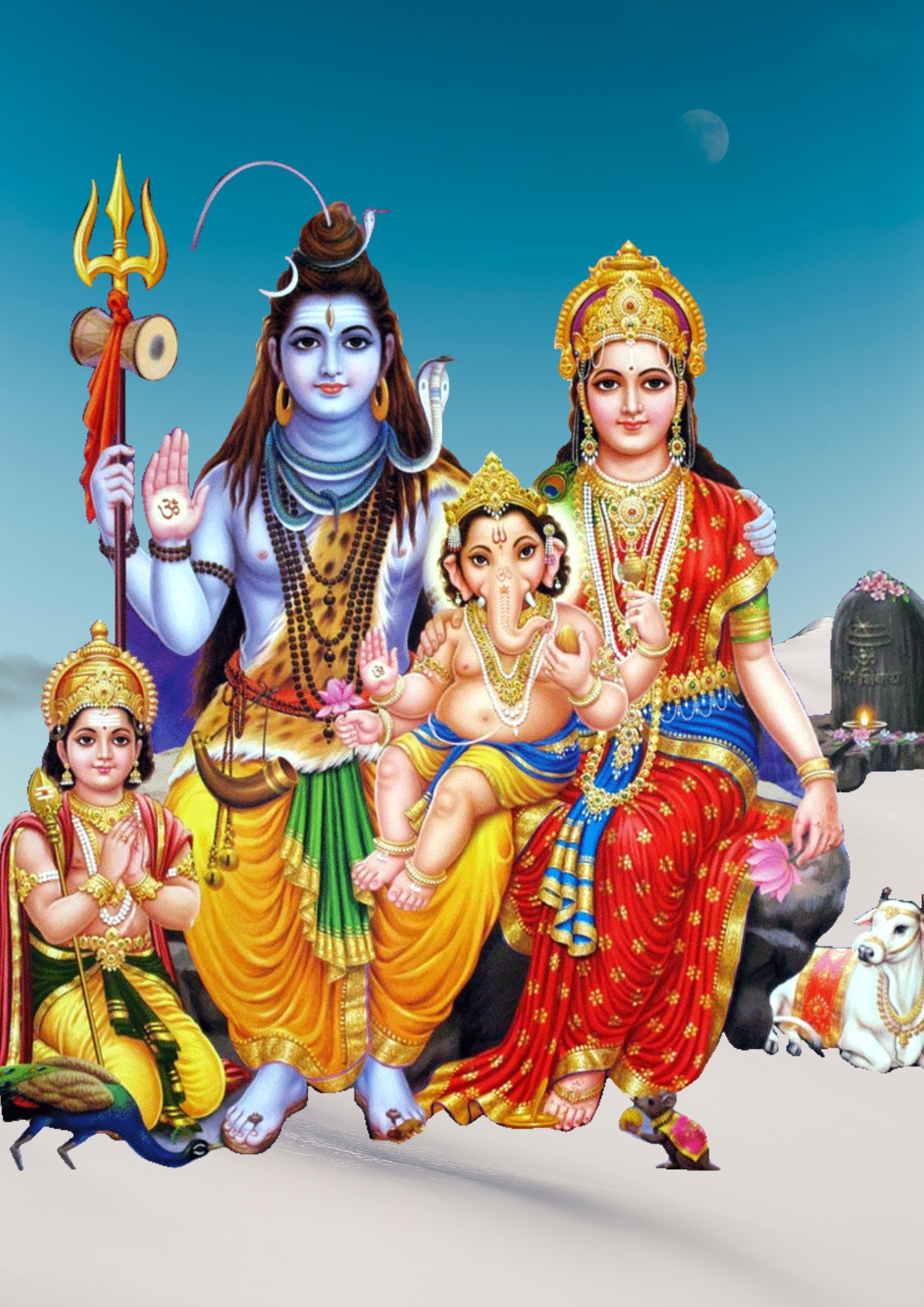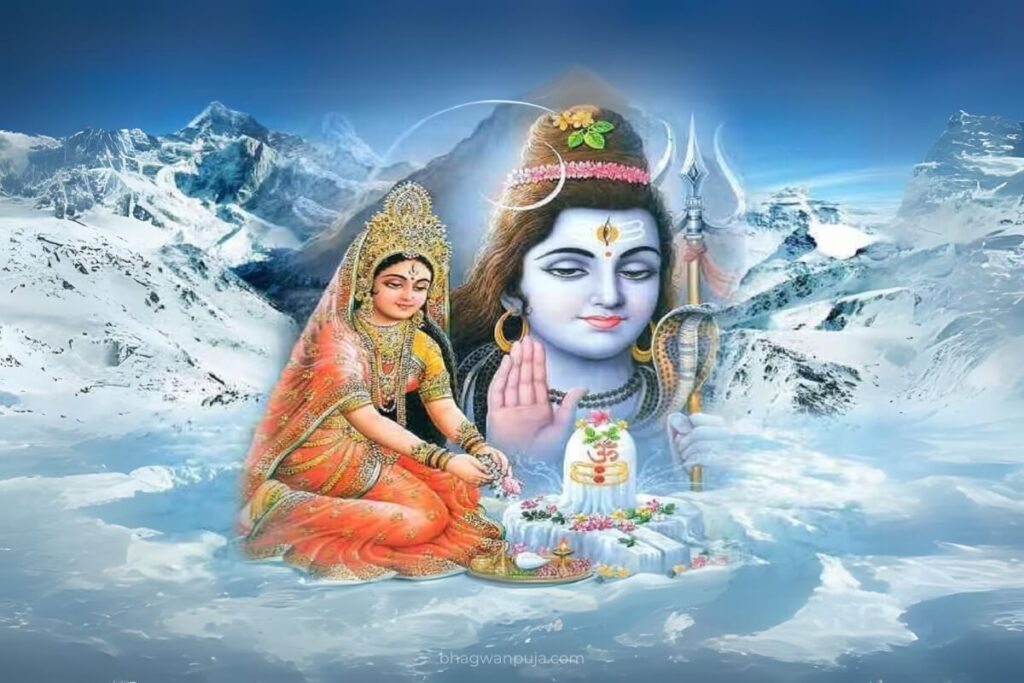Goddess Parvati is the Hindu Goddess of power, energy, nourishment, harmony, love, beauty, devotion, and motherhood. In her complete form, she is a physical representation of Mahadevi which is also known as Adi Shakti. She has a primordial power behind the creation of the universe, the creator and destroyer. She is the one of central deities of the Goddess Goddess-oriented sect called Shaktism and the supreme goddess in Shaivism. Along with Lakshmi, and Saraswati, they form Tridevi.
Who is Goddess Parvati?
Goddess Parvati is the wife of the Hindu god Shiva. She is the reincarnation of Sati, the first wife of Shiva who immolated herself during a yajna (fire-sacrifice). Parvati is the daughter of the mountain king Himavan and Queen Mena. Whereas Parvati is the mother of the Hindu deities Ganesha and Kartikeya. The Puranas also reference her to be the sister of the river goddess Ganga, and the preserver god Vishnu. For Shaivites, she is considered to be the divine energy between a man and a woman, like the energy of Shiva and Shakti.
Generally, Parvati is portrayed as a gentle, nurturing mother goddess, but is also associated with several fearsome forms to vanquish evil beings such as Durga, Kali, the ten Mahavidyas, and the Navadurgas.
Parvati is an embodiment of Shakti. In Shaivism, she has the recreative energy and power of Shiva, and she is the cause of a bond that connects all beings and a means of their spiritual release. She is also known as Kamarupa (the embodiment of one’s desires) and Kameshvari (the lady of one’s desires). In Hindu temples dedicated to her and Shiva, she is symbolically represented as the argha.
Different Names of Maa Parvati and Their Meanings
Firstly discuss from where her name Parvati derived. Parvati is one of the Sanskrit words for mountain ‘Parvati’ derived her name from being the daughter of King Himavan also called Himavat Or Parvat and mother Mena. Whereas Parvat is considered Lord of the Mountain and personification of the Himalayas. From there Parvati implies she of the mountain.
Parvati is famous by many names in Hindu literature. Other names that associate her with mountains are Shailaja (Daughter of the mountains), Adrija or Nagaja or Shailaputri (Daughter of Mountains), Haimavati (Daughter of Himavan), Devi Maheshvari, and Girija or Girirajaputri (Daughter of the king of the mountains).
The Shaktas consider the Parvati as an incarnation of Lalita Tripurasundari. Two of Parvati’s most famous epithets are Uma and Aparna. The name Uma is used for Sati (Shiva’s first wife, who is reborn as Parvati) in earlier texts, but in the Ramayana, it is used as a synonym for Parvati. In the Harivamsa, Parvati is referred to as Aparna (‘One who took no sustenance’) and then addressed as Uma, who was dissuaded by her mother from severe austerity by saying u ma (‘oh, don’t’). She is also referred to as Ambika (‘dear mother’), Shakti (‘power’), Mataji (‘revered mother’), Maheshvari (‘great goddess’), Durga (invincible), Bhairavi (‘ferocious’), Bhavani (‘fertility and birthing’), Shivaradni (‘Queen of Shiva’), Urvi or Renu, and many hundreds of others.
History and origin of Goddess Parvati
According to the research, the word Parvati does not explicitly appear in Vedic literature instead Ambika, Rudrani, and others are found in the Rigveda. From verse 3.12 of the Kena Upanishad till mid 1st millennium BCE, there is a goddess called Uma Haimavati, which is a very common alternative name for Parvati. She appears as the shakti, or essential power, of the Supreme Brahman. Her primary role is as a mediator who reveals the knowledge of Brahman to the Vedic Trideva of Agni, Vayu, and Varuna, who were boasting about their recent defeat of a group of demons.
Both Sati-Parvati appear in the epic period (400 BCE–400 CE), in both the Ramayana and the Mahabharata present Parvati as Shiva’s wife. However, it is not until the plays of Kalidasa (5th–6th centuries) and the Puranas (4th through the 13th centuries) that the stories of Sati-Parvati and Shiva acquire more comprehensive details. Kinsley adds that Parvati may have emerged from legends of non-aryan goddesses that lived in mountains. While the word Uma appears in earlier Upanisads, Hopkins notes that the earliest known explicit use of the name Parvati occurs in late Hamsa Upanishad.
However, Weber suggests that just like Shiva is a combination of various Vedic gods Rudra and Agni, Parvati in the Puranas text is a combination of the wives of Rudra. In other words, the symbolism, legends, and characteristics of Parvati evolved fusing Uma, Haimavati, and Ambika in one aspect and the more ferocious, destructive Kali, Gauri, and Nirriti in another aspect. Tate suggests Parvati is a mixture of the Vedic goddesses Aditi and Nirriti, and being a mountain goddess herself was associated with other mountain goddesses like Durga and Kali in later traditions.
Attributes of Goddess Parvati
Maa Parvati is often depicted holding various objects, each symbolizing different aspects of her divine nature and powers. Here’s a detailed look at these objects:
- Lotus:
- Symbolism: Purity, beauty, and spiritual enlightenment.
- Meaning: The lotus represents the unfolding of spiritual consciousness and the purity of the soul. Despite growing in muddy waters, it blooms untainted, signifying Parvati’s ability to remain pure and virtuous amid worldly distractions.
- Vase (Kalasha):
- Symbolism: Abundance, prosperity, and fertility.
- Meaning: The vase often contains sacred water and symbolizes life-giving forces. It represents Parvati’s nurturing aspect and her role as a life-giver and sustainer.
- Rosary (Japa Mala):
- Symbolism: Devotion, meditation, and spiritual knowledge.
- Meaning: The rosary beads indicate Parvati’s deep meditative and contemplative nature. It underscores her connection to spiritual practices and her role as a guide to spiritual enlightenment.
- Mirror:
- Symbolism: Self-reflection, inner beauty, and truth.
- Meaning: The mirror symbolizes self-awareness and the importance of looking within to understand one’s true nature. Parvati, as a mirror-holder, encourages introspection and self-knowledge.
- Trident (Trishula):
- Symbolism: Power, protection, and the triad of creation, preservation, and destruction.
- Meaning: The trident is a powerful weapon representing Parvati’s dynamic energy and her ability to destroy evil forces. The three prongs signify her control over the three aspects of existence: creation, sustenance, and destruction.
Gesture of Granting Boons
Parvati is sometimes shown with her hand in a gesture known as the “Varada Mudra”, which means the gesture of granting boons. This gesture typically involves the palm facing outward with fingers pointing downwards.
- Symbolism: Compassion, generosity, and blessings.
- Meaning: The Varada Mudra signifies Parvati’s benevolent nature and her readiness to bestow blessings and boons upon her devotees. It reflects her role as a compassionate mother who listens to and fulfills the wishes of those who seek her blessings.
Story of Goddess Parvati’s Marriage and her family
 For Parvati, it’s not easy to make Shiva fall in love with her. She waited on him like a servant, trying to help Shiva out of his depression, but he would not even look at her. She withdrew to the forest as an ascetic, which is someone who undergoes self-discipline and avoids partaking in the desires of the flesh. Parvati was given the name Aparna during this period.
For Parvati, it’s not easy to make Shiva fall in love with her. She waited on him like a servant, trying to help Shiva out of his depression, but he would not even look at her. She withdrew to the forest as an ascetic, which is someone who undergoes self-discipline and avoids partaking in the desires of the flesh. Parvati was given the name Aparna during this period.
Because Parvati was on a similar ascetic level as Shiva after her time as Aparna, then he decided to marry her. The two lived in the kingdom of Kailasa, which was on top of the mountain at the center of the universe. They lived together well, partaking in dice and other games together. Because Shiva was supposed to have a great warrior son, Parvati helped him birth Kartikeya by passing Shiva’s seed along to various deities to create this god. Parvati wanted another son, though Shiva did not, and decided to make one from clay and earth. This became Ganesha, the elephant-headed god.
Sati returns as Parvati’s stories
She has many famous stories, but this is one of the most important and famous stories of them. After Sati’s death, Lord Shiva was devastated. He went to the Himalayas and completely secluded himself. He went into deep meditation. In the meantime, the demon Tarakasura won a boon from Lord Brahma that he should die only at the hands of the son of Lord Shiva and his wife. He thought that, as Sati was dead and Lord Shiva was alone in the forest, there would be no children. Therefore, he would be immortal.
But concerned gods went to King Himavan and requested that he have Sati as his daughter. Himavan agreed, and Sati was born as Parvati. However, according to Nard Muni’s oracle, she could marry Lord Shiva only after severe penance. So she practiced austerity to please Lord Shiva, and finally, their union was blessed.
How does Goddess Parvati represent?
Goddess Parvati generally appears as a gentle mother. She is also seen in their form such as Durga and Kali. But these are shown to be calm. Parvati is beautiful and benevolent. Sometimes she is portrayed as a golden complexion, which symbolises her as the goddess of harvest and fertility. She is often depicted in a red sari. She is shown with two arms when she appears alongside Lord Shiva. Alone, she is shown with four arms. One of her children, Ganesha, is often seated on her lap. Her second child, Skanda or Kartikeya, may be seen playing near her.
Her one hand displays the Abhaya mudra (gesture for fear not). It may also be shown in kataka (a gesture of fascination and enchantment). Her left hand sometimes shows Tarjani mudra (a gesture of menace).
Sometimes, she has a parrot near her shoulder, which symbolizes cheerful and loving talk. Also, a crescent moon is shown on her head, which symbolizes her being half Shiva. Parvati is frequently depicted as the ideal housewife who cares for her family and society.
